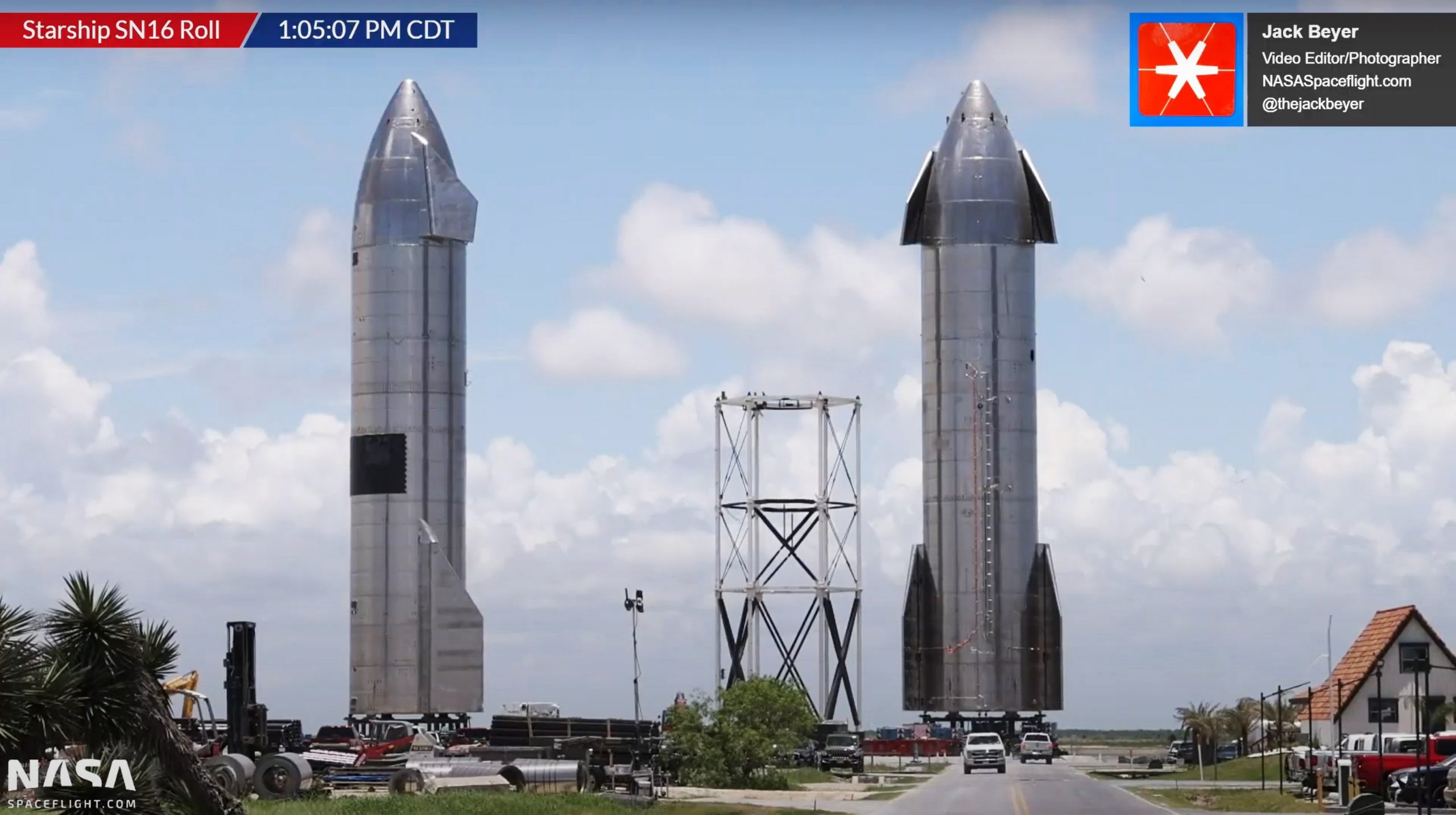

News
[Update: not so fast…] SpaceX retires brand new Starship to focus on orbital launch buildup
SpaceX has moved its newest finished Starship straight from its Boca Chica, Texas factory to a nearby ‘rocket garden,’ all but guaranteeing an early retirement.
Built as the first of several planned backups to Starship SN15, which debuted a number of significant upgrades in April and May, it appears that Starship serial number 16 (SN16) has been retired to a display stand after its only sibling became the first full-size prototype to successfully survive a launch and landing on May 5th. SN16 actually reached its full height before SN15 lifted off and was more or less complete by May 10th. Since then, the prototype has remaining more or less untouched, seemingly waiting for SpaceX to decide its fate in lieu of Starship SN15’s major success.
Ultimately, with SN16 now sitting side by side with SN15 at what will likely become a sort of open-air SpaceX museum, it appears that the company has made up its mind.
Once SN15 touched down, safed itself, and remained standing after a near-flawless 10 km (6.2 mi) test flight, questions about Starship SN16’s fate almost immediately arose. From the outside looking in, replicating that spectacular success was judged a logical next step by many in light of the four variously unsuccessful Starship launches that closely preceded it. If SpaceX could land SN15 and then successfully recover an entirely separate Starship weeks later, it would all but eliminate the possibility that – much like several different failure modes popped up on SN8 through SN11 – the first total success was a fluke.
Given that SN16 was quite literally completed within days of SN15’s launch and landing, it seemed an almost foregone conclusion that SN16 would fly. For a few weeks, it even looked possible that SpaceX would attempt to reuse Starship SN15. However, SpaceX appeared to decide against reuse and rolled its first flight-proven full-size Starship from the pad to a plot of land expected to host a future ‘garden’ for retired SpaceX rockets.
After its three intact flight-proven Raptor engines – valuable in their own right – were removed, Starship SN15 was seemingly retired around May 26th. Three weeks later, SN16 has (quite literally, to an extent) followed in SN15’s footsteps, bowing to an apparently virulent desire within (or at least atop) SpaceX to launch Starship into space and orbit as quickly as possible. From that perspective, assuming enough data was gathered by Starship SN15 to encourage significant confidence that its survival wasn’t an ‘accidental success,’ reusing Starship SN15 or flying Starship SN16 would only really benefit a line of prototypes that had just made itself obsolete.
Much like Starship SN15 debuted “hundreds of improvements” across the board, CEO Elon Musk revealed that Starship SN20 would also involve a “major technology [revision]” to produce the first prototypes with full heat shields, a stage separation mechanism, vacuum-optimized Raptor engines, and more. In fact, that process may still be ongoing, which could explain why SpaceX has yet to begin assembling Starship SN20 – various subsections and components of which have already been completed in Boca Chica.
Confirmed by Musk in March, SpaceX has been working towards a target of no later than July 2021 for Starship’s first orbital test flight. Given that Starship SN20 has yet to enter the assembly phase and that Super Heavy “Booster 2” (BN3) will be the first of its kind and likely need to pass several major tests on its own, July is no longer within reach. Of course, an orbital launch attempt anytime in 2021 would still be a staggering achievement for SpaceX, beating the likes of Vulcan Centaur, New Glenn, and Ariane 6 to the punch despite Starship’s superior performance, unprecedented design challenges, and grander ambitions.
Elon Musk
Elon Musk confirms Grok 4 launch on July 9 with livestream event
The rollout will be accompanied by a livestream at 8 p.m. Pacific Time.

Elon Musk has officially confirmed that Grok 4, the latest version of xAI’s large language model, will launch on July 9. The rollout will be accompanied by a livestream at 8 p.m. Pacific Time, hosted on xAI’s official account on X.
xAI goes straight to Grok 4
Back in May, leaks indicated that xAI was getting ready to ship Grok 3.5. Considering Musk’s recent comments, however, it appears that the artificial intelligence startup would be focusing on the large language model’s fourth iteration instead. As noted in a Financial Express report, users on X have sighted references to Grok 4 in the lead up to the update’s launch, such as “grok-4-prod-mimic” and “Grok 4 Code.”
Musk’s Grok 4 announcement comes as AI competition intensifies between major players including OpenAI, Google, and xAI. With Musk’s Colossus supercomputer fully operational in Memphis, xAI appears to be accelerating its AI product roadmap.
Musk pushes Grok toward political neutrality
Grok 4’s launch also follows a recent controversy involving political bias, as noted in a CNN report. Last week, Grok responded to a user on X stating that political violence in the U.S. since 2016 had come more from the political right than the left. The chatbot noted in a later reply that its answer was based on information from sources like Reuters, the Journal of Democracy, and University of Maryland studies.
Musk stated that Grok’s response was a “major fail.” “Major fail, as this is objectively false. Grok is parroting legacy media. Working on it,” he wrote in a post on X. By the end of June, Musk noted that he was “grinding all night with the xAI team” and that they were making “good progress.” He also stated that the model “Will be called Grok 4. Release just after July 4th. Needs one more big run for a specialized coding model.”
News
Tesla opens massive solar Supercharger station in California
The Supercharger opened to customers ahead of Fourth of July weekend, while Tesla continues phase two of construction on the site.
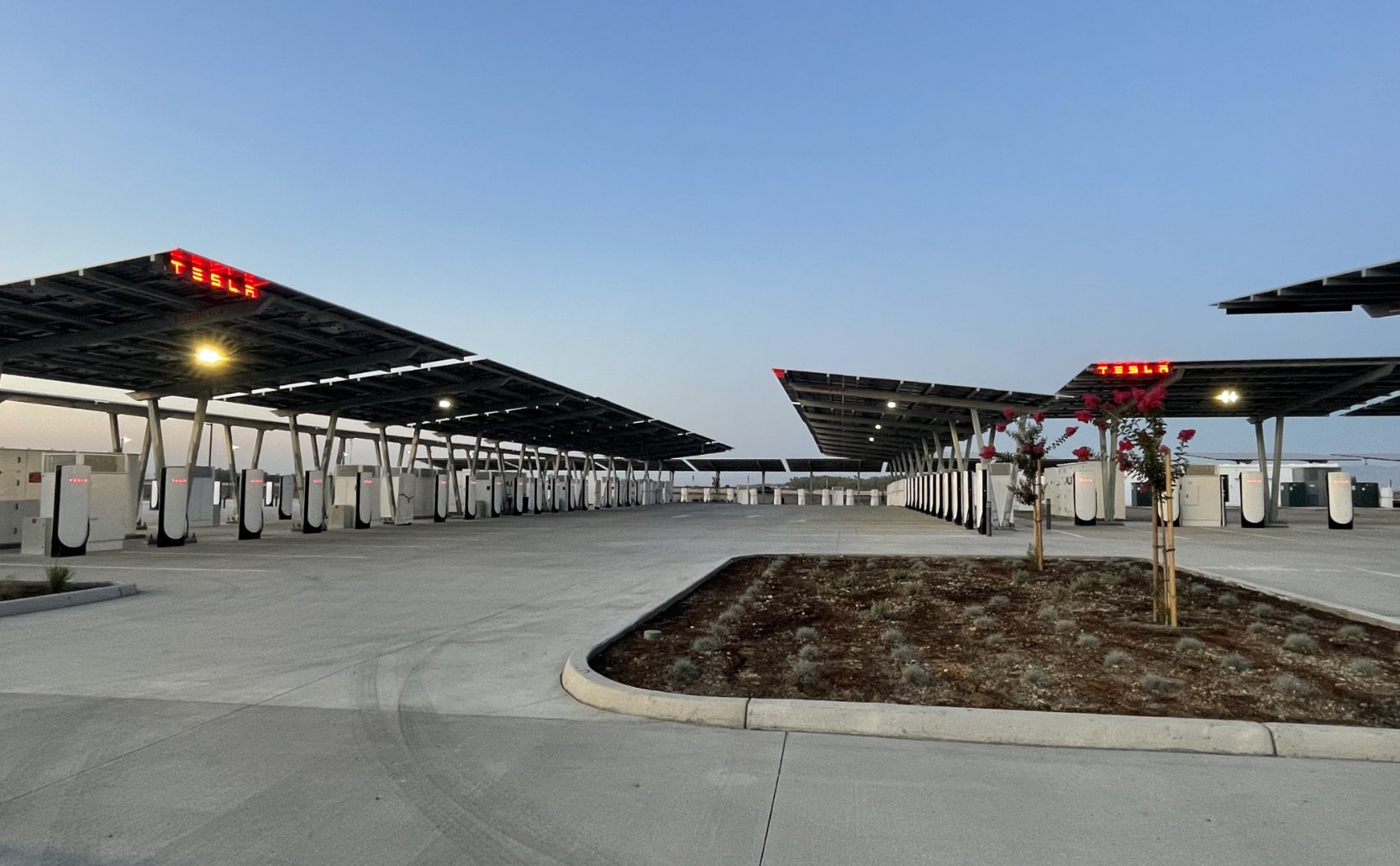
Tesla has officially launched the first several Supercharging posts at a massive station in California, notably including solar canopies and grid-scale batteries to offer completely renewable charging.
Last week, Tesla announced on X that it opened the first 84 Supercharger stalls of a planned 168-stall station in Lost Hills, California. Additionally, the massive Supercharger project features 11MW of solar canopies and 10 Megapack batteries for off-grid charging powered entirely by solar energy.
Tesla completed the first phase of the project just days ahead of the busy Fourth of July holiday weekend, adding that initial construction took just eight months. In addition to the remaining charging stalls, Tesla says it’s building a set of lounge areas, renderings of which can be seen below alongside current photos of the site.
Notably, the site also includes V4 charging posts for the company’s latest available charging speeds, and it’s located near the busy junction between I-5 and Highway 46 in Kern County.
“Thank you [Kern County] and [PG&E] for collaboration and approvals,” Tesla wrote in a follow-up post.
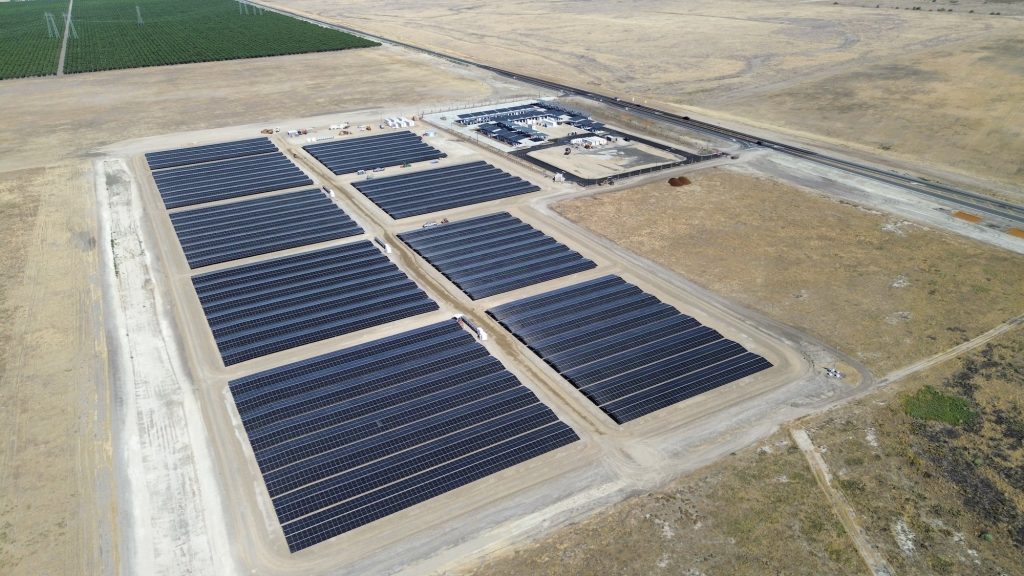
Credit: Tesla Charging | X
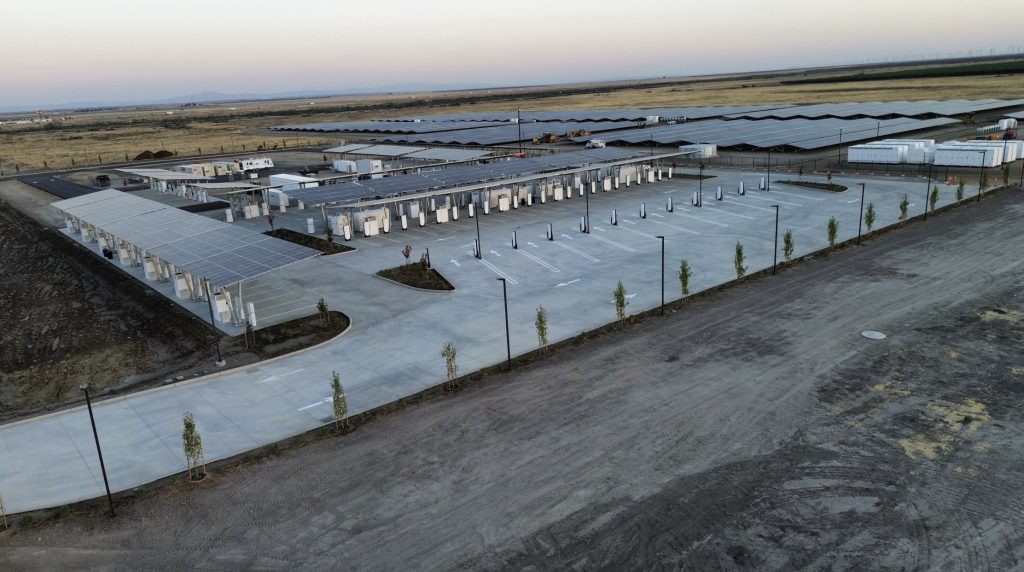
Credit: Tesla Charging | X
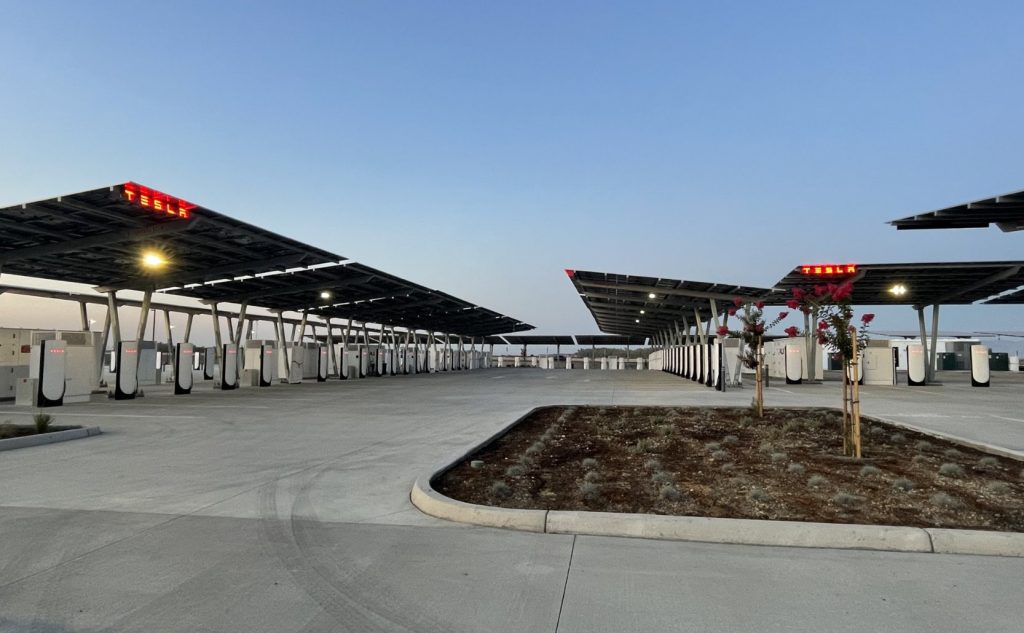
Credit: Tesla Charging | X
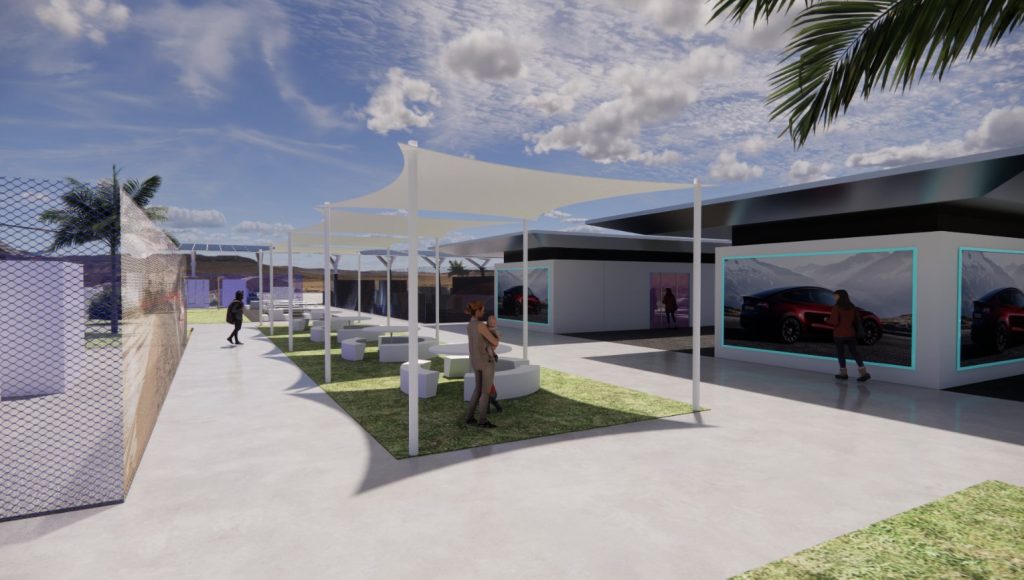
Credit: Tesla Charging | X
Tesla Supercharger Maps for North America, Europe, and Asia pic.twitter.com/0U5r0XRPyo
— TESLARATI (@Teslarati) July 2, 2025
READ MORE ON TESLA SUPERCHARGERS: Tesla launches ultra-fast V4 Superchargers in China for the first time
Testing at the LA Diner, plus Musk update on potential Tesla solar Gigafactory
The huge Tesla Supercharger station completed phase one of construction fairly quickly, especially given how long Tesla has been working on its unique Los Angeles diner, drive-in, and Supercharger location. Still, the company was seen performing some testing at the nearly-completed charging station earlier this month, and will reportedly be holding a job fair.
Elon Musk also responded on Monday morning to a post on X, suggesting that Tesla is “thinking about” building a U.S.-based solar Gigafactory in order to help support increased power needs with AI growth, and to bolster domestic solar production.
Tesla is building a new UFO-inspired Supercharger in the heart of Alien country
News
Tesla driver walks away from major accident with minor injuries
The driver sustained only minor injuries, and the exact cause of the crash remains under investigation.

The driver of a Tesla Model Y survived and walked away from a harrowing accident on Monday in California, only sustaining minor injuries despite the vehicle being impaled by a guardrail.
On Monday morning around 4:34 a.m., the Los Banos division of the California Highway Patrol (CHP) responded to the accident on I-5 near Panoche Road, involving a 23-year-old in a Tesla Model Y. According to a post on social media, the driver veered off the road for unknown reasons in the northbound lane, before crashing directly into the guardrail and impaling the vehicle.
You can read the full message and photos from Los Banos CHP below, as were shared in a Facebook post on Monday afternoon.
This morning a Tesla model y was traveling in the #1 northbound lane of I-5 north of Panoche Rd. For unknown reasons driver allowed V-1 to veer off the roadway, travel through a dirt center divide, and crashed into the fixed metal guardrail. Lucky for the driver he only sustained minor injuries and was able to walk away. Driving a vehicle requires 100% attention to the road. Avoid distractions and focus on driving.

Credit: CHP Los Banos (via Facebook)

Credit: CHP Los Banos (via Facebook)
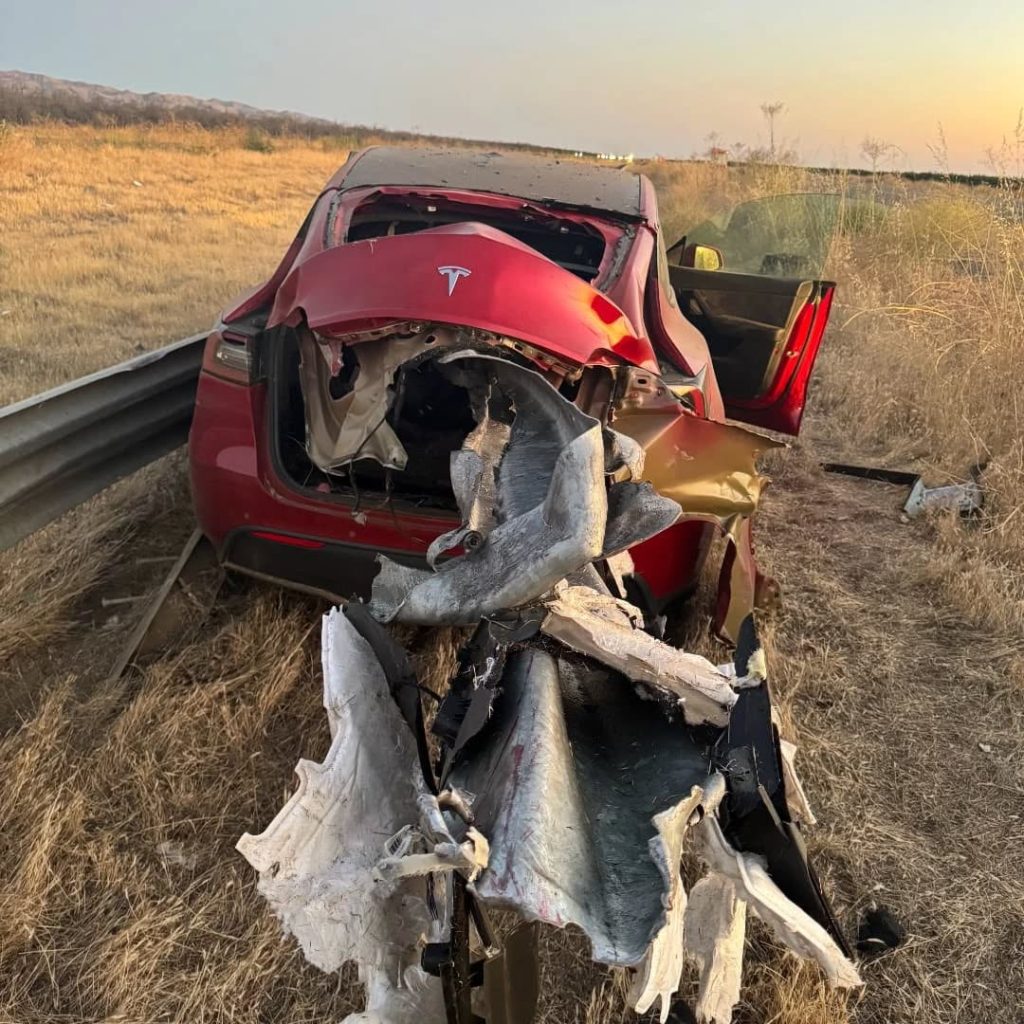
Credit: CHP Los Banos (via Facebook)
In a statement to SFGate, CHP officer Myles Anderson said that the driver only sustained minor injuries, while no arrests are made and drugs and alcohol are not suspected to have been involved. The report also notes that Tesla’s “cruise control and lane assistance features” were activated, according to Anderson. However, it’s not entirely clear if this is referring to Supervised Full Self-Driving (FSD), or to the cruise control and lane assist features baked into Autopilot.
At the time of writing, CHP has not yet responded to Teslarati’s request for clarification and additional details on the matter.
Tesla Crash Safety Ratings across its lineup: pic.twitter.com/ny30R7ceji
— TESLARATI (@Teslarati) July 1, 2025
READ MORE ON TESLA SAFETY: Tesla rolls out crucial new safety feature aimed at saving children
The news comes after Tesla has touted its vehicles as incredibly safe for many years. In December, for example, the company highlighted receiving top safety scores from regulators on four different continents throughout the world, including from the National Highway Traffic Safety Administration (NHTSA) and the Insurance Institute of Highway Safety (IIHS) in the U.S.
Tesla has also listed the goal of making its vehicles the safest on the road throughout the years, both in the overall design of its vehicles and in its Autopilot and Full Self-Driving (FSD) programs.
Tesla Model 3 ranks as the safest new car in Europe for 2025, per Euro NCAP tests
-

 Elon Musk1 week ago
Elon Musk1 week agoTesla investors will be shocked by Jim Cramer’s latest assessment
-

 News2 weeks ago
News2 weeks agoTesla Robotaxi’s biggest challenge seems to be this one thing
-

 News2 weeks ago
News2 weeks agoWatch the first true Tesla Robotaxi intervention by safety monitor
-

 Elon Musk2 weeks ago
Elon Musk2 weeks agoA Tesla just delivered itself to a customer autonomously, Elon Musk confirms
-

 News2 weeks ago
News2 weeks agoTesla Robotaxi rollout proves that Elon Musk still delivers, even if it’s late
-

 Elon Musk2 weeks ago
Elon Musk2 weeks agoxAI welcomes Memphis pollution results, environmental groups push back
-

 Elon Musk2 weeks ago
Elon Musk2 weeks agoElon Musk commends Tesla team on successful Robotaxi launch
-

 Elon Musk2 weeks ago
Elon Musk2 weeks agoElon Musk confirms Tesla Optimus V3 already uses Grok voice AI


















